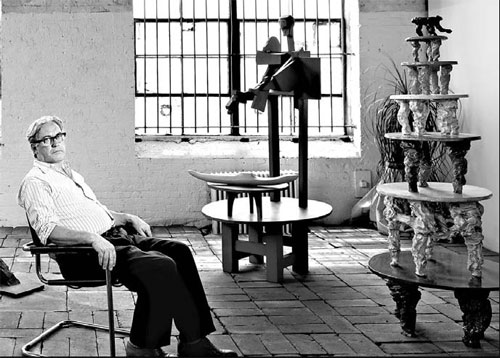A globetrotting sculptor's works find a home
Updated: 2012-09-09 08:09
By Dorothy Spears (The New York Times)
|
|||||||||||
|
The Brazilian-born artist Saint Clair Cemin has returned to New York, where his works are being exhibited in two shows. The sculptor in his Brooklyn studio. Brian Harkin for The New York Times |
As a child the sculptor Saint Clair Cemin lived for two years on his mother's 2,025-hectare property in rural Brazil, where his father, an engineer, tried and failed to grow wheat. This was in the late 1950s, when the area surrounding the small city of Cruz Alta was, he said, "still known as gaucho land, as primitive as the American West in the 19th century." There was no running water or electricity.
"It was a beautiful time of my life," Mr. Cemin, 60, said. "And I think all of my work has been inspired by it."
Seven of his sculptures, displayed in New York's parks and pedestrian malls along Broadway between 57th and 157th Streets, reveal the extent to which this is true. Presented by the Broadway Mall Association in collaboration with the Paul Kasmin Gallery in the Chelsea neighborhood - which is mounting a concurrent show of Mr. Cemin's work - "Saint Clair Cemin on Broadway" includes "In the Center" (2002), a two-meter-tall semi-abstract figure sporting a gaucho hat and holding a divining rod, believed to help locate water. Mr. Cemin recently explained how the sculpture's title is related to his mother's property, where the family survived on well water. "Art is perception," he said, "and in the center of perception is this strange faceless giant that looks for things - looks for water - and finds it."
His work is arguably more focused on the juxtapositions of different worlds than on any single one. An itinerant artist who speaks five languages, including Russian, he employs a dazzling variety of materials, subjects and sculpture traditions from around the world, often combining them to surprising and sometimes humorous effect.
Another work in the Broadway exhibit, a hammered copper sculpture called "Aphrodite" (2006), refers to the Greek goddess of love and also calls to mind Zulu wood carvings. In the show at Paul Kasmin a new bronze piece, "And Then (I Close My Eyes)," features what may be "a distracted meditating person" from our own culture, Mr. Cemin said, or "an imperfect Buddha." (The works on Broadway are on view through November and the Kasmin show, "Saint Clair Cemin: Six," runs through October 13.)
"Saint Clair's work relates to the theories of the French anthropologist Claude Levi-Strauss," said the painter Peter Halley. "Around the world he finds hints of language that people from other cultures can relate to."
Born in 1951, Mr. Cemin moved with his family from Cruz Alta to Sao Paulo as a teenager. He fell in with a group of Surrealists and eventually attended the Ecole Nationale Superieure des Beaux-Arts in Paris, which may explain why he embraces traditional techniques and handmade virtuosity. Feeling restless, he moved to New York in 1978, working as a printmaker until a Joseph Beuys retrospective at the Guggenheim a year later introduced him to a new range of possibilities.
"That was really a turning point," he said.
He dabbled with a more conceptual approach to art, "making drawings and doodles," he said, until the summer of 1983. Mr. Cemin closed himself off in a room for a week.
Seated at a table with a few basics - paper, pencils, paints and clay, he confronted what he called "the essential condition of every human," and made whatever he wanted. "I was open to anything," he recalled.
He modeled some 50 objects, "mugs with faces in them; strange, decorative or erotic objects; little animals; all sorts of things," he said. In the process he realized "that my conceptual framework was totally destroyed, because the objects themselves were so much more powerful than the concept."
Determined to accept himself as a sculptor, he brought stone to his studio and "began to carve."
Mr. Cemin was already part of New York's exploding East Village art scene of the '80s, having befriended artists like Jeff Koons and Mr. Halley. His work was selling in solo shows in New York, Los Angeles and Rome, and he was included in shows put on by Collins & Milazzo, a dynamic curatorial team at the time.
But he was soon restless again. In 1992 he rented a large house outside of Aswan, Egypt, where he made watercolors and iron sculptures. Two years later he enlisted carvers in Bali to help him produce pieces in teak and mahogany. And in 1999 he began making sculptures in Beijing.
The exhibits on Broadway and at Kasmin are a kind of coming home for Mr. Cemin. In August, the wayward artist signed a lease on a New York apartment. Piles of raw marble are stacked at his Brooklyn studio, including a 1,360-kilogram stone he said was "just asking to be carved."
He seemed excited about his return. "I'm going to be spending a lot more time here now," he said.
The New York Times
Today's Top News
Rescuers race against time for quake victims
Telecom workers restore links
Coal mine blast kills 18 in Jilin
Intl scholarship puts China on the map
More bird flu patients discharged
Gold loses sheen, but still a safe bet
US 'turns blind eye to human rights'
Telecom workers restore links
Hot Topics
Lunar probe , China growth forecasts, Emission rules get tougher, China seen through 'colored lens', International board,
Editor's Picks

|

|

|

|

|

|






